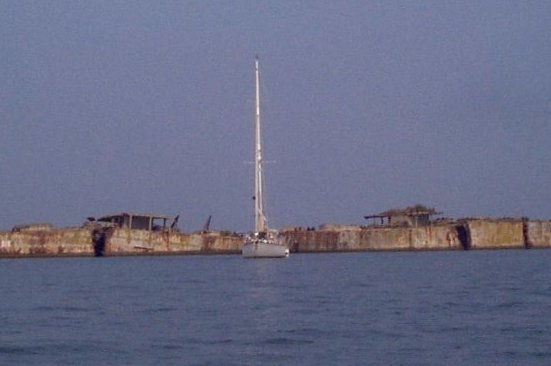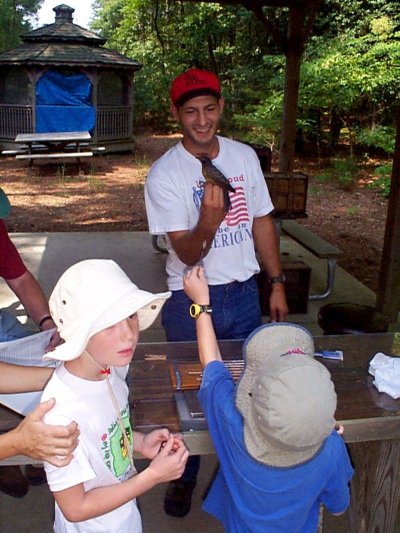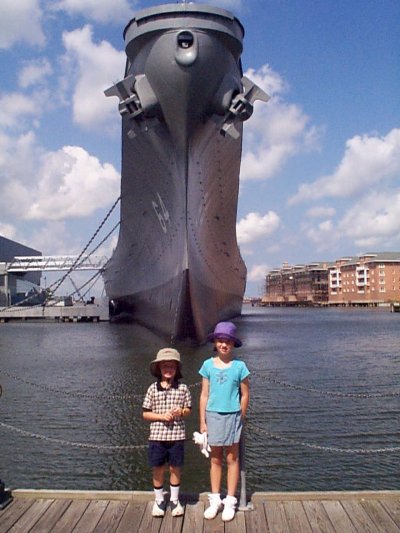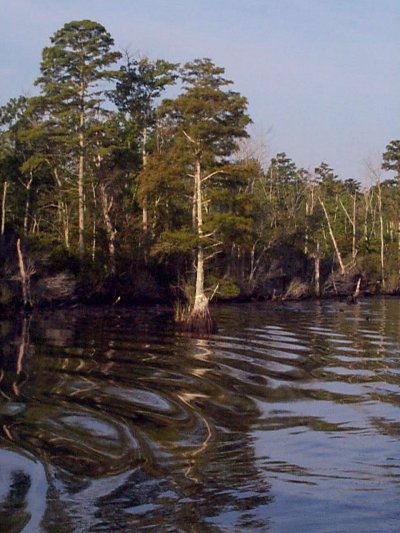Chesapeake Bay to New Bern
Annapolis, MD
While anchored in Spa Creek, we meet Irene, Lucas, and their two gregarious teenage daughters, Heather and Theresa (twins) aboard their (for the moment) mastless sailboat, Kiva. Kiva is a ketch (i.e. it normally has two masts) and is in Annapolis to have new masts made up, as the old ones were showing rot. They anchored next to us, and Heather wanted to come over to show us their "dog," which actually turned out to be a rabbit. (They delighted in calling their rabbit a dog.)
Heather and Theresa have been across the Atlantic on Kiva five times, and have been schooled by their parents for several years. They certainly are a credit to home-schooling! For this coming school year, Heather and Theresa were going back across the Atlantic, but on a plane, to attend a boarding school in Ireland. We are invited to their home town, Onancock, to visit.
Angie would like to visit Tangier Island anyway, so we decide to visit Onancock, too, but after we make a trip to DC. Early (6am) on a Monday morning, we take a communter bus to DC, visit Smithsonian museums for a whirlwind two days, and then return to Annapolis, where Luke takes Kristina for an hour-long "dinner cruise" in the dinghy. Next time we will take Canto to DC.
Coming from the deep South, where Catholic churches are rare, we're surprised to find how many are in Maryland. It seems we can't go to shore anymore without bumping into one. St. Mary's, in Annapolis, is a 5 minute trip (boat to church) from where we've anchored. We go to morning mass on St Rose of Lima's feast day, and, as things go, a man at the church, who lives near Spa Creek, introduced himself and said that he had seen the children out rowing the dinghy. He invites us for bagels and coffee, and introduces us to a group of St. Mary's parishioners, one of whom was also a graduate of Spring Hill College! Several in the group had seen our boat anchored out in the creek, and they generously welcome us and even offer the use of a car. It will be hard to leave tomorrow!
Tangier Island
We have a romp of a sail down to Solomon's Island - the wind is steady and fresh, and the Monitor steers the whole way - downwind! We stay the night in Solomon's Island, and the next day pick up and sail to Tangier Island.
On the approach to Tangier Island, we see the GPS reading 10 degrees higher than our ship's compass. Since we had recently swung the compass, the intrepid skipper deduces that the error must be due, not to a misadjusted compass or maljunctioning GPS, but to a strong current, which is also making the crabpots throw big wakes. We end up crabbing almost sideways into theTangier Island channel.
Tangier Island was settled by the British. It is a remote and low-lying island, and for many years was accessible only by shallow-draft boat. Its inhabitants remained sympathetic to the British during the American Revolution, and the British maintained a presence on the island until the early 1800s. Reportedly, all the native trees were cut down to make repairs to the British fleet. To this day, some islanders speak with an Elizabethan accent, most have one of five or six surnames ("Crockett" is very common), and many are blond-haired and blue-eyed.
We arrive in Tangier after phoning ahead to "Parks Marina" for a dock, and are placed at the end of a pier. Our deep draft prevents us from tying up in a slip. Alas, the dockmaster makes two unfortunate mistakes which prejudice the first mate against Tangier Island: 1). he addresses her as "Luv," and 2). he refuses to take the spring line which she throws him (he throws it back into the water, insisting that she first toss him the bowline). We were going to stay for two nights, but Angie pays for only one and tells the dockmaster we'll let them know about tomorrow.
A fellow from the Chesapeake Bay Foundation arrives shortly after us, and gives us a plate of cookies and a bag of fresh tomatoes. The cookies just disappear!
An exploration of Tangier reveals that most of the homes are ringed by picket fences, and several have graves in their yards. However, the islanders apparently think nothing of disposing of engines and vacuum cleaners in the waterways, and, judging by the lack of greetings we receive, are not particularly receptive to strangers. We also discover that the island is not very large and after about forty minutes, we're done with our walking tour. There are very few cars on the island; most folks get around with golf carts. We stop by the famed Hilda Crockett's restaurant only to discover that it is closed already (at 5:30pm). Adrian thinks, "No problem, we'll just go there tomorrow." but Angie, who is definately thinking of leaving tomorrow, thinks to herself, "Oh well, guess we won't be trying Hilda's."
Back on Canto, while the spaghetti is cooking, Adrian lays down in the V-berth for a rest. A cat appears at the hatch over his head. "Nice kitty" barely leaves his mouth when the cat lifts his tail, and, as Luke tells it, "The cat littered on Dad." What a stink! Adrian takes a shower, and we try to air out our bedspread while salvaging our spaghetti-with-fresh-tomato-sauce dinner. After the cats, gnats, mosquitoes, and the large wakes from the passing locals, we ALL decide that we've seen enough of Tangier Island.
Onancock
We depart at first light. The wind is delightfully fresh, but from the wrong direction. We beat against wind and chop to Onancock Creek, covering Canto with salty spray. Inside Onancock Creek, the wind is light, and we motor the remaining distance.
Onancock is a small town on the Eastern Shore of the Chesapeake, only about 15 miles from Tangier Island. As Irene put it, Onancock is a "real town," which means that it supports itself not with tourism, but with other industry. Onancock is a "deepwater" port on the Eastern Shore and in the past was well travelled by shipping traffic to the numerous plantations.
We meet Irene at her real estate office and are warmly received. Irene offers her Grand Cherokee for our use while we stay, and, though we have just provisioned in Annapolis, we accept the offer and drive up the road to a shopping center, where we pass the afternoon in a bookstore. At Irene's urging, we visit two of the local restaurants - "Tail Fins" and a French restaurant. Both are quite good.
After two nights in Onancock, it's time to move on. Lucas brought Kiva, with her new masts, down from Annapolis (staying up 24 hours to do so in one trip) and tells us that the town docks are free for a 2 hour stay. Water is also free. We weigh anchor early in the morning and tie up to fill our water tanks, as we wish to top-off before heading down the ICW. Lucas also recommends not making the entire trip to Norfolk from Onancock, but to visit Kiptopeke Beach, near Cape Charles on the Eastern Shore, instead. This is a shorter trip, and we decide to do that instead of making the long haul to Norfolk.
Kiptopeke Beach
 After filling our water tanks and giving Canto a good rinsing, we head out. We thank dead dinosaurs on the trip, because the day is flat calm. Kiptopeke Beach is on a fairly featureless portion of the Eastern Shore, close to the mouth of Chesapeake Bay and lying between the town of Cape Charles and the promentory named Cape Charles. The only protection from the Chesapeake - and, in fact, from the Atlantic Ocean - are five sunken concrete ships. These ships were purchased in Beaumont, Texas and towed all the way to Kiptopeke to form a ferry breakwater. The ferry no longer operates - it was put out of business by the Chesapeake Bay Bridge Tunnel - but the breakwater still does a fair job of protecting Kiptopeke Beach. However, the anchorage would be miserable in a real storm. The ships also are home to many coastal birds.
After filling our water tanks and giving Canto a good rinsing, we head out. We thank dead dinosaurs on the trip, because the day is flat calm. Kiptopeke Beach is on a fairly featureless portion of the Eastern Shore, close to the mouth of Chesapeake Bay and lying between the town of Cape Charles and the promentory named Cape Charles. The only protection from the Chesapeake - and, in fact, from the Atlantic Ocean - are five sunken concrete ships. These ships were purchased in Beaumont, Texas and towed all the way to Kiptopeke to form a ferry breakwater. The ferry no longer operates - it was put out of business by the Chesapeake Bay Bridge Tunnel - but the breakwater still does a fair job of protecting Kiptopeke Beach. However, the anchorage would be miserable in a real storm. The ships also are home to many coastal birds.
The water here is relatively clean and Kiptopeke Beach State Park hosts a beautiful sandy swimming beach. We spend the rest of the afternoon swimming and building fine sand fortresses.
We learn from one of the other swimmers that there is a bird banding station here, so the next day, after schoolwork has been completed, we row ashore and walk up to the banding station. Numerous nets have been set up. We learn that, in the fall, a wide variety of migrating birds pass through Kiptopeke Beach due to its geography: Cape Charles forms the end of the long Delmarva peninsula and birds migrating south down the coast are funneled down this peninsula until they reach Cape Charles, where they must then cross the Chesapeake Bay. The best time to watch birds being banded is in the early morning; the bander begins work around 6:30 am and finishes by about 2:30pm. We happen in at a slow time; only two robins are banded while we are there.
While we were transiting a wider part of the Delaware Bay, a small bird came and landed in our cockpit, panting. We gave it some saltine cracker crumbs and water, and it sat in the shade. After about an hour, it flew away again. At Kiptopeke, we learn that this is a common occurance: birds commonly land on yachts or ships for a rest.
Since this is Labor Day weekend, the State Park has several special programs planned. Tonight, we learn, there will be a Native American drum program. That night on the beach, the large drum is heated over a campfire, and we listen to Native American song. We rebuild our sandcastles and regret that we have miss the rest of the weekend's programs. The weather forecast predicts bad weather coming through late the next day and we feel our anchorage would be uncomfortable - if not miserable - during a storm.
Southbound through Norfolk
We weigh anchor early in the morning. The only two other boats at Kiptopeke are also leaving, and one of these, Gigolo, was in Onancock at the same time we were. The wind is brisk, and is coming from the direction in which we want to go (Norfolk). Gigolo raises sail and motorsails to windward, apparently beating away to some point farther up the Bay. We try raising our sails to get some drive, but they are counterproductive on our course, so we decide to just crash on through the wind and waves under power.
We had met some folks in Onancock who told us that Gigolo had nearly completed a westward circumnavigation, having just crossed the Atlantic on their way back home to California.
The day is overcast and cool, with spurts of rain. Canto bashes through the swells under power with a relatively comfortable motion. On the VHF radio, we hear lots of Naval warships passing by the "Charlie" buoy off the Chesapeake Bay. Later in the day, as we approach Norfolk, we can see them steaming by. A Naval submarine also calls in - we keep a sharp lookout for it.
Meanwhile, Gigolo, whom we had assumed was heading farther up the Bay, has tacked back, and is now approximately abeam of us - it looks as if they, too, are heading for Norfolk.
The only sailing we do this day is once we turn into the Elizabeth River. We put up full sail, shut down the engine, and scream up the river with the rail almost in the water. We do have to tack once or twice (the wind seems determined to stay on our nose), but there's plenty of room and traffic is not heavy. We walk away from the Navy warship being escorted up our wake, and from Gigolo. Looking back, we finally catch a glimpse of the submarine we'd been hearing about. It would have been neat to get a closer look, but we are already quite a ways up the Elizabeth.
We sail to our anchorage off Hospital Point and drop the anchor. Alas, owing to the crabpots and a somewhat tired skipper, we have anchored too close to another vessel and must start our engine to raise our anchor to move farther away. (The anchor windlass draws a good bit of power, so we like to run the engine when operating it to limit the voltage drop it creates). It is at this time that our starter refuses to operate. We consider raising the anchor using the manual windlass handle, and then sailing to a new spot, but finally, after abusing the starter with a hammer, we manage to get the engine started and move to a better location. We add "starter rebuild" to our to-do list. Incidently, our alternator has been whining when it'sunder load (an indication of failing bearings) and we add "alternator rebuild" to our list as well.
The weather front slowly passes through over the next two days, and we have more rainwater in our dinghy that we've ever seen. We decide to row over to Norfolk where the library, which has a children's room, is within easy walking distance. There, we pass the day wonderfully while it pours outside.
Norfolk to New Bern
We leave on a Sunday afternoon to begin our trip south. We have a number of bridges and a lock to pass through, so we make our first destination Great Bridge, which is only a short distance from Norfolk. From Great Bridge, the next convenient stop is across the Currituck Sound, so we leave early on Monday. The post frontal wind is fresh and from the northeast. We leave the diesel going in the narrow, shallow channel to afford better control should things get dicey, but we unfurl our entire jib and fly down the Currituck Sound at close to 8 knots.
About halfway down the sound, our fuel filter clogs and our suspicion that the port fuel tank is is validated. We shut the engine down and, still blasting along under sail, Adrian changes the filter and switches over to the starboard tank, which we cleaned in Annapolis. We are approaching the narrow land cut into Coinjock, and so must get the engine running again. Again, the starter plays its game with us, but, evidently recalling the beating it received in Norfolk, gets back to work after only two raps of the hammer; the diesel comes back to life.
In Coinjock, we decide to take on an additional 30 gallons of diesel in order to ensure we have enough for our trip back to New Bern should the wind fail entirely. We are also considering overnighting at the Coinjock Marina. When the man who takes Angie's spring line said, "I don't want your spring line - I want your bow line, Luv," I knew we'd be moving on..
 The hands in Coinjock don't get very excited about folks taking on only 30 gallons of fuel. We are told that, to fill our 5 gallon solar shower, we'd have to pay $5.00. Only one person reluctantly shows up to help us cast off. We shake the Coinjock dust from our sandals and proceed south to Buck Island where we anchor for the evening. Tomorrow's forecast for the Albemarle Sound is none too good, and we are thinking that we'll have to stay at Buck Island for some time.
The hands in Coinjock don't get very excited about folks taking on only 30 gallons of fuel. We are told that, to fill our 5 gallon solar shower, we'd have to pay $5.00. Only one person reluctantly shows up to help us cast off. We shake the Coinjock dust from our sandals and proceed south to Buck Island where we anchor for the evening. Tomorrow's forecast for the Albemarle Sound is none too good, and we are thinking that we'll have to stay at Buck Island for some time.
On Tuesday, Adrian wakes before dawn to a dead calm. The nasty conditions forecast for the Albemarle that day have been put off until the afternoon. If we leave immediately, we should be across the sound and past the Alligator River Bridge (which closes in bad weather) before any bad weather sets in. The rest of the crew awakens to the sound of the engine starting.
We have calm conditions down North River, across the Albemarle Sound, through the bridge, and down the Alligator River. It is still only about 13:00 (1pm) when we arrive at Deep Point in the Alligator River, where we had planned to anchor. If we proceed down the Pungo and Alligator canal (the next leg of the trip), we should still be at anchor before nightfall. We decide to go for it and enter the canal.
We arrive in the Pungo River tired but pleased - we are now quite close to New Bern, and could easily make it there by Thursday or even Wednesday. However, we arrange to meet our dear friend Bob at Dowry Creek Marina on Wednesday, so that he might sail down to New Bern with us. Bob had not been sailing all summer due to health problems, and no sooner had our invitation left our lips than he said "yes!" Later, we learned that he had some 'splainin' to do with his wife.
Canto pulls into Dowry Creek Marina, which is just lovely, and meet Bob. We spend the afternoon swimming in the pool, and have a delicious dinner at the clubhouse. Afterwards, we watch "Titanic" on the clubhouse's VCR (fastforwarding at strategic moments) and turn in late.
We leave around 9am and there is enough wind to set some sail. We sail across the Pamlico River in light wind, and then motor through the Hobucken cut. Arriving in Bay River, we are presented with a fresh breeze (on the nose, of course) and must beat our way out of the river. Canto likes this point of sail - we simply lock the helm down and Canto shoulders her way out of the river so quickly that none of us can quite believe it when we are already at the Neuse River marker. We have made good time, so we decide to pass by South River and anchor the night in Oriental.
In Oriental, we anchor behind the breakwater with plenty of breeze blowing across the boat, providing us with all the wind-generated power we could ask for and providing for most excellent ventilation belowdecks. In the harbor, there are people trawling for shrimp in open, aluminum skiffs. Bob remarks that times must be hard for fishermen. We have dinner onboard and turn in early.
New Bern is only 15 miles from Oriental, and we arrive at Northwest Creek early in the day. We've been gone for almost three months, but it seems like only yesterday that we left. After some quick tying-up and cleaning, we head over to the pool, where we spend the rest of the afternoon. It is bittersweet being back; we simultaneously wish we are still cruising and are glad to be back. However, we now have a fairly good list of things we wish to do on Canto before departing for points south, are we are eager to start on these so we can shove off again.
 After filling our water tanks and giving Canto a good rinsing, we head out. We thank dead dinosaurs on the trip, because the day is flat calm. Kiptopeke Beach is on a fairly featureless portion of the Eastern Shore, close to the mouth of Chesapeake Bay and lying between the town of Cape Charles and the promentory named Cape Charles. The only protection from the Chesapeake - and, in fact, from the Atlantic Ocean - are five sunken concrete ships. These ships were purchased in Beaumont, Texas and towed all the way to Kiptopeke to form a ferry breakwater. The ferry no longer operates - it was put out of business by the Chesapeake Bay Bridge Tunnel - but the breakwater still does a fair job of protecting Kiptopeke Beach. However, the anchorage would be miserable in a real storm. The ships also are home to many coastal birds.
After filling our water tanks and giving Canto a good rinsing, we head out. We thank dead dinosaurs on the trip, because the day is flat calm. Kiptopeke Beach is on a fairly featureless portion of the Eastern Shore, close to the mouth of Chesapeake Bay and lying between the town of Cape Charles and the promentory named Cape Charles. The only protection from the Chesapeake - and, in fact, from the Atlantic Ocean - are five sunken concrete ships. These ships were purchased in Beaumont, Texas and towed all the way to Kiptopeke to form a ferry breakwater. The ferry no longer operates - it was put out of business by the Chesapeake Bay Bridge Tunnel - but the breakwater still does a fair job of protecting Kiptopeke Beach. However, the anchorage would be miserable in a real storm. The ships also are home to many coastal birds.

 The hands in Coinjock don't get very excited about folks taking on only 30 gallons of fuel. We are told that, to fill our 5 gallon solar shower, we'd have to pay $5.00. Only one person reluctantly shows up to help us cast off. We shake the Coinjock dust from our sandals and proceed south to Buck Island where we anchor for the evening. Tomorrow's forecast for the Albemarle Sound is none too good, and we are thinking that we'll have to stay at Buck Island for some time.
The hands in Coinjock don't get very excited about folks taking on only 30 gallons of fuel. We are told that, to fill our 5 gallon solar shower, we'd have to pay $5.00. Only one person reluctantly shows up to help us cast off. We shake the Coinjock dust from our sandals and proceed south to Buck Island where we anchor for the evening. Tomorrow's forecast for the Albemarle Sound is none too good, and we are thinking that we'll have to stay at Buck Island for some time.